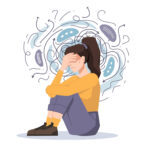Hi Friend,
There are three remedies I carry in my purse at all times; Apis, Aconite and Arnica. When I go on vacation, I add a few more just to be safe. Years of traveling with kids and to unusual places has taught me that it’s essential to be prepared for anything. The last thing I want to do is hunt down remedies in a foreign country, or have to sit out of an activity because I don’t feel well enough.
You would be amazed how much I use my remedies when we travel. On a recent trip to Central America, a place I later learned was near “The Mosquito Coast”, I made use of my entire battery of remedies treating my family. Someone had anxiety and panic from the small planes and bad roads – treated with Aconite. All 10 of us were assaulted by jungle flies that bit our arms and legs and caused major swelling, itching and oozing – treated with Apis. Someone had seasickness from a small boat in choppy seas on our way to snorkel – treated with Cocculus. Someone had excessive soreness and stiffness from so much hiking – treated with Rhus-tox. Several of us had small cuts and scrapes from jungle walking – treated with Calendula. Someone had nausea from eating unadvised street food – treated with Arsenicum. Someone got some bruises while cave exploring – treated with Arnica. Someone got extreme sunburn – treated with Apis. Your family will thank you if you travel prepared this summer. Read on for the list of the remedies I take with me whenever I travel, and a link to download a handy travel guide.
PACKING LIST
ACONITE:
Think of it for: Anxiety about flying, anxiety about undertaking something scary, or after shocking events. Also for the first 24 hours of acute inflammatory diseases or fevers. May follow a traumatic event or exposure to wind, cold weather or extreme heat.
Keynotes: Sudden onset of symptoms. Fearful. Flushed face alternating with pale face. Very thirsty. Senses are over-acute. Restless anxiety.
Example: Someone is feeling panicky about a scuba dive or plane flight, they are hyperventilating and sweaty.
APIS:
Think of it for: Insect stings, allergic reactions – hives or rash with swelling.
Keynotes: Swelling, shiny, red. Sharp, stinging, burning pain. Hives from contact with food or environmental allergens. Lack of thirst. Rapid onset. Better from cold applications (ice, cold water). Worse from heat.
Example: Someone got stung by a bee on the cheek and it is painful, red and swollen.
ARNICA:
Think of it for: Injuries, falls, bruising to soft tissue.
Keynotes: Bruising with a feeling of being sore and bruised. Denial of help (“I’m fine, don’t touch me”). Worse from being touched or approached. Restless from feeling unable to get comfortable.
Example: Someone fell and has a bruise on their hip that is black and blue.
ARSENICUM:
Think of it for: Food poisoning, gastroenteritis
Keynotes: Restless, fastidious. Burning pains, discharges. Thirst for small sips. Anxiety. Fear to be alone. Chilly. Desires warm drinks. Vomiting or diarrhea, or both simultaneously. Seems sicker than the illness warrants. Worse at midnight, from cold, wet, and drafts. Better from warmth.
Example: Someone drank some unfiltered water and started having diarrhea and vomiting. They are chilly and need your company.
CALENDULA:
Think of it for: Cuts, wounds, abrasions.
Keynotes: Mainly useful for treatment of wounds, abrasions and incisions. Calendula works as an antiseptic and helps to prevent serious infection when used topically. Topically it will often control bleeding from wounds of any sort, and it will soothe pains in the wounds as well.
Example: Someone gets a cut, and it needs healing balm and a bandaid.
COCCULUS:
Think of it for: Motion sickness, nausea, vertigo.
Keynotes: Nausea from circumstances such as motion, not from food. Carsickness or seasickness. Vertigo from watching moving objects from a train or car, causing nausea or dizziness. Worse from the thought of food. Headache.
Example: Someone is feeling really sick while driving on a windy road.
COLOCYNTHIS:
Think of it for: Diarrhea, abdominal cramps.
Keynotes: Extreme, cutting, cramping, neuralgic pains. Abdominal pains which are better from bending double or from applying hard pressure and heat. Anger and screaming with the pain. Better from bending double, pressure, warmth.
Example: Someone has bad cramping from some street food and is doubled over in pain.
LEDUM:
Think of it for: Insect stings, bites, puncture wounds.
Keynotes: The wound is like a white doughnut with a red, indented center. It is cold and feels better from cold applications. The wound bleeds scantily, but is followed by puffiness, pain, and coldness of the part. The pain is tearing or stabbing.
Example: Someone got stung by a wasp, and it’s white and swollen and painful.
PODOPHYLLUM:
Think of it for: Diarrhea, gastritis.
Keynotes: Painless or involuntary diarrhea. Explosive and profuse diarrhea. Stool is watery, profuse, offensive. Stool with undigested food in it. Faintness after diarrhea. Nausea, uncertainty if he is to vomit or have diarrhea.
Example: Someone has eaten something that disagrees and they have profuse watery diarrhea.
RHUS TOXICODENDRON:
Think of it for: Poison oak, strains and sprains.
Keynotes: Strains and sprains from overexertion. Stiffness, soreness. Cannot get comfortable. Feeling of weariness. Restlessness. Cramps in legs that feel achy. Worse from first moving around, but better from loosening up. Better from heat. Worse from cold and wet. Burning, itching vesicular skin eruptions (poison oak).
Example: Someone has walked a few too many miles and is sore and stiff the next day, or they have twisted their ankle.
Wishing you safe travels!
Alexis





